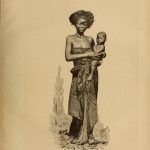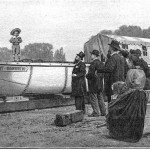This the third and final installment of National Museum of African Art Library volunteer Judith Schaefer’s series on David Livingstone. See Part I and Part II. “In Congo, unrelenting violence” more »
Tag: National Museum of African Art
This post is the second in a three post series by National Museum of African Art Library volunteer Judy Schaffer. If you missed the first installment, posted right before our shutdown-induced hiatus, check it out here.
“. . . this trade in Hell, this open sore of the world . . .”
David Livingstone’s first book, Missionary travels and researches in South Africa, published in 1857, was a huge success, not only because of the harrowing adventures it related but because it alerted the British public to the existence of the Arab slave trade flourishing along Africa’s east coast. The book, along with Livingstone’s many lectures and letters, provoked a call for action once again, and finally, in 1873, a few weeks after Livingstone’s death, Parliament outlawed this trade, too (the West Coast trade had been outlawed in 1834). The Royal Navy sent ships to Africa to enforce the ban.
2013 marks the bicentennial of Scottish explorer David Livingstone (1813-1873). His explorations in central Africa are well known – – “Dr. Livingstone, I presume.” Less well known is his first-hand encounter with the horrors of the Arab slave trade in East Africa. Two Smithsonian Libraries – – the Warren M. Robbins Library at the National Museum of African Art and the Joseph F. Cullman 3rd Library at the National Museum of Natural History – – have exceptional collections on David Livingstone and 19th-century African exploration. Drawing upon our Smithsonian Libraries’ resources, volunteer Judith Schaefer recounts David Livingstone and the other slave trade.
 The Cultural Heritage Library (CHL) has been through a few incarnations over the last 3 years but the content remains the same. It is a digital collection that includes materials from the History, Art, and Culture libraries within the Smithsonian. The collection has been developed using branch librarian’s selections as well as items that have been identified as being relatively scarce according to OCLC holdings. Subject headings are part of the descriptive metadata for each title and are available to browse from the Internet Archive website, providing an at-a-glance overview of the collection.
The Cultural Heritage Library (CHL) has been through a few incarnations over the last 3 years but the content remains the same. It is a digital collection that includes materials from the History, Art, and Culture libraries within the Smithsonian. The collection has been developed using branch librarian’s selections as well as items that have been identified as being relatively scarce according to OCLC holdings. Subject headings are part of the descriptive metadata for each title and are available to browse from the Internet Archive website, providing an at-a-glance overview of the collection.
In honor of National Volunteer Week, please enjoy this illuminating post by National Museum of African Art branch library volunteer, Judy Schaefer. Judy is one of many hard working volunteers at the Smithsonian Libraries and we appreciate each and every one!
In 1902, Commander Eugène Lenfant traveled from Paris to Lake Chad in a mere 75 days. He was looking for a cheap, fast, and humane way to supply the French Sudan—”Afrique française” on the map—and he found one by ascending the Niger, Benue, Kebi, and Chari rivers all the way to the lake.
A while ago, before the internet, I became interested in studying Saharan rock art, one of the most beautiful and extensive bodies of prehistoric art, but documentary references were hard to find. This is partly because most of the published literature on Saharan rock art is in French, Italian and German.

